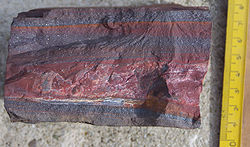Sedimentary rock

Sedimentary rocks are rocks formed from sediment. They are deposited over time, and often show layers which can be seen in cliffs. Other types of rock are igneous rock and metamorphic rock.
Sediments are usually formed from matter which falls to the bottom of oceans and lakes. The matter includes tiny pieces of other rocks, and dead animals, plants and microorganisms. Also, inorganic chemicals may be precipitated from solution in the water. The three most common sedimentary rocks are limestone, sandstone and shale.[1]
Sedimentary rocks cover 75–80% of the Earth's land area, but they make up only 5% of the Earth's crust. The relative abundances of the different types of sedimentary rocks are:
Consolidation
Squeezed and compressed over time, the sediments become 'consolidated' (made solid) into layers of rock. Stratigraphy is the study of those layers
Cementation occurs when dissolved mineral components deposit in the interstices of sediments. It is the sticking together of sediment that forms a rock.
Otherwise, rocks may have the water squeezed out, yet remain for long periods with their character unchanged. There are many quarries of unconsolidated deposits where sand and gravel are removed for the construction industry. Such quarries may be taking out sand which has lasted as sand since the Jurassic period. But consolidated sand, sandstone, can be a very hard rock.
Consolidated rocks may be changed some more, by water seeping through, or by heat and extreme pressure.
Types of sedimentary rock
Sediments are formed by three processes:
- Solids swept down from the land.
- Bits & pieces laid down in water, e.g. shells.
- Chemicals in solution, which may be precipitated.
These sedimentary processes – weathering, transportation, and deposition – reach three final end products: quartz sand, shale (from clay), and limestone (CaCO3). Most sedimentary rocks are variations on this general pattern.
Chalk, limestone, and dolomite are all basically made from calcium carbonate. This comes from a mixture of minerals and pieces of animals (especially animal shells). They are mostly formed in oceans. Shales, sandstones, and conglomerates are all clastic rocks. They are made from pieces of other rocks. The pieces may have come from erosion by water, ice or wind. Coal is made from ancient plants; oil and natural gas is also organic in origin.
Some sedimentary rocks are made of just one type of sediment, all about the same size, such as sand. Other sedimentary rocks will have large and small lumps, and pieces of different types of rock. Well-known sedimentary rocks are sandstone and limestone.
Sedimentary rocks may be found anywhere on Earth. When sedimentary rocks are heated and squeezed, they become metamorphic rocks. Igneous rocks have a volcanic origin. Over a very long time, rocks get recycled, in two ways. When marine sediments are raised above sea level, they get weathered, and the pieces carried down to the sea. On a much longer time-scale continental plates may collide. Then one plate goes under the other (is subducted), and all its material is recycled, emerging much later.
Sedimentary Rock Media
Middle Triassic marginal marine sequence of siltstones (reddish layers at the cliff base) and limestones (brown rocks above), Virgin Formation, southwestern Utah, U.S.
Uluru (Ayers Rock) is a large sandstone formation in Northern Territory, Australia.
Claystone deposited in Glacial Lake Missoula, Montana, United States. Note the very fine and flat bedding, common for deposits coming from lake beds further away from the source of sediment.
Sedimentary rock with sandstone in Malta, southern Europe
Lower Antelope Canyon was carved out of the surrounding sandstone by both mechanical weathering and chemical weathering. Wind, sand, and water from flash flooding are the primary weathering agents.
Outcrop of Ordovician oil shale (kukersite), northern Estonia
Fossils of Nerinea marine gastropods of Late Cretaceous (Cenomanian) age, in limestone in Lebanon
Cross-bedding and scour in a fine sandstone; the Logan Formation (Mississippian) of Jackson County, Ohio
A piece of a banded iron formation, a type of rock that consists of alternating layers with iron(III) oxide (red) and iron(II) oxide (grey). BIFs were mostly formed during the Precambrian, when the atmosphere was not yet rich in oxygen. Moodies Group, Barberton Greenstone Belt, South Africa
Related pages
References
- ↑ Blatt H; Middleton G. & Murray R. 1980. Origin of sedimentary rocks. Prentice-Hall. ISBN 0-13-642710-3
- Blatt, Harvey and Tracy, Robert J. 1996. Petrology: igneous, sedimentary and metamorphic, Freeman, 2nd Ed. ISBN 0-7167-2438-3
- Folk R.L. 1965. Petrology of sedimentary rocks PDF version Archived 2006-02-14 at the Wayback Machine. Austin: Hemphill’s Bookstore. 2nd ed. 1981, ISBN 0-914696-14-9
- Basic sedimentary rock classification Archived 2011-07-23 at the Wayback Machine
| Wikimedia Commons has media related to Lua error in Module:Commons_link at line 62: attempt to index field 'wikibase' (a nil value).. |












